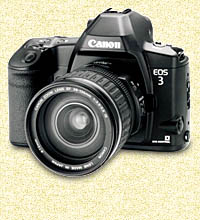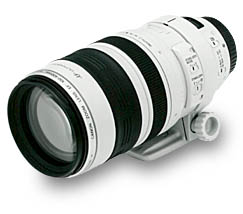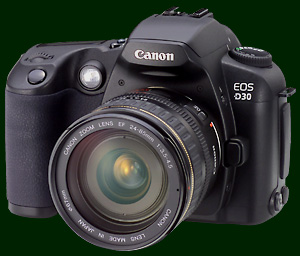TheCanon EOSSystem
 There are many reasons to commit oneself to a particular camera system. Great new cameras such as theEOS3andEOS-1vare one reason, but for me, the selection of lenses is primary. Canon’s is extensive, high quality, and has a number of unique technologies and capabilities. In fact,the announcementby Canon U.S. on May 31, 1999 of 4 new fast super-telephoto prime lenses usingImage Stabilization(IS) technology added significant weight to this.
There are many reasons to commit oneself to a particular camera system. Great new cameras such as theEOS3andEOS-1vare one reason, but for me, the selection of lenses is primary. Canon’s is extensive, high quality, and has a number of unique technologies and capabilities. In fact,the announcementby Canon U.S. on May 31, 1999 of 4 new fast super-telephoto prime lenses usingImage Stabilization(IS) technology added significant weight to this.
At one time I was a prime lens snob. Zooms were for the uninitiated, and only prime focal length optics could provide ultimate image quality. While it’s possible that from a strictly theoretical point of view this is still correct, in the real-world top quality zooms such as those in the Canon L series are capable of results that will satisfy even the pickiest photographer. The convenience of using zooms is unquestioned, and so for my 35mm work (which is largely about convenience), I have made the switch.
After a couple of years of slowly building a complete system here is what is in my current optical arsenal:
Sigma 14mm f/2.8
Canon 17~35mm f/2.8L zoom
Canon 24mm f/3.5L Tilt /Shift
Canon 28~70mm f/2.8L zoom
Canon 28~135mm f/3.5-f/5.6 IS zoom
Canon 50mm f/1.4
Canon 100mm f/2.8 Macro
Canon 70~200 f/2.8L zoom
Canon 100~400 f/4.5-f/5.6L IS zoom
Canon 300mm f/2.8L IS
Most of these lenses are from Canon’s "L" series. This family of lenses are Canon’s finest, utilizing ED and Fluorite elements as well as aspherical designs where appropriate. Needless to say they are pricey — but I believe well worth the money.
This isn’t to say that Nikon doesn’t have similar quality optics in their line-up. They indeed do. But, four of these lenses are unique to Canon, the 24mm T/S and the three Image Stabilized lenses, the 100~400mm zoom, 28~135mm zoom and the 300mm f/2.8L .
I have also enjoyed playing with a twenty year-old 800mm f/11Vivitar Series One Solid Catadioptric Lens.
Below are some observations on lenses I own which incorporate Canon’s T/S and IS lens technology.
![]() February, 2001: Below are some comments on several Canon lenses, but for a more complete look at what I use and what I think about them have a look atCanon Lenses‚ A Personal Selection.
February, 2001: Below are some comments on several Canon lenses, but for a more complete look at what I use and what I think about them have a look atCanon Lenses‚ A Personal Selection.
![]() Popular Photography magazine in their February 2000 issue has a major review of the EOS3. Worth reading if you’re thinking about buying this camera, or even if you already own one.
Popular Photography magazine in their February 2000 issue has a major review of the EOS3. Worth reading if you’re thinking about buying this camera, or even if you already own one.
Tilt / Shift
The 24mm Tilt / Shift (T/S) and the 45 and 90mm lenses in this series are capable of simultaneous tilts and shift on the same, or opposing axes. These lenses are so invaluable that Nikon users still look for Canon’s older FD mount tilt / shift lenses and have them converted to a Nikon mount, (at some expense).
Yellow Stripe Hwy, outside Monument Valley, 1999
Taken with aCanon EOS3and Canon 24mm L T/S f/3.5 lens on Provia 100.
This picture, and the one below are linked to the pages on this site entitledThe Southwest, where more detailed descriptions of how they were shot will be found. Use your browser’s BACK button to return here.
Biblical Sheep— Monument Valley, 1999
Taken with aCanon EOS3and Canon L 100~400mm IS zoom, at 400mmhandheldat 1/125sec.
This shot was the result of jumping from a Jeep, and hand-holding at 1/125sec at 400mm — wide open. Moments later the goat and sheep disappeared behind a cliff face. Before IS technology lenses, such a shot would have a 90% chance of being blurred by hand shake, but amazingly, of the two frames shotbothwere pin sharp. This electronic gyroscope lens control is the same as used in Canon’s highly popular (and breathtaking) binoculars, and video cameras. Probably the most significant technological advance in lens technology of the 90’s.

Image Stabilization (and other Canon lens technology) can be read abouthere. Needless to say I believe that the two photographs above — of the highway and the sheep — could not have been taken with virtually any lenses other than the ones used. My spring 1999 trip toMonument Valleywas inaugural for the Canon gear, and I couldn’t be more pleased with the images that resulted. Clickhereto read that article.
There are some lenses that have almost universal appeal for photographers. Fast ultra-long telephotos are among these and few lenses are as appealing as a 300mm f/2.8. At the top of the heap of this rarified grouping are the new (1999) Image Stabilized (IS) ultra-telephotos from Canon‚ the 300mm f/2.8, 400mm f/2.8, 500mm f/4 and 600mm f/4 IS lenses, part of Canon’s top-of-the-line "L" series. In January 2000 I purchased the 300mm f/2.8L IS. This was to enable me to pursue a broader interest in nature and wildlife work in addition to my landscape photography.
If you want to really extend the reach of your Canon long lens, try a technique invented by George Lepp. It involves having both the 1.4X and the 2X Canon tele-extenders along with a 12mm extension tube. Place the 1.4X on the body first, then the 12mm extension tube and then the 2X extender. Mount your long lens on the end of this and voila, you have the equivalent of a 2.8X extender that will focus on infinity with many of Canon’s long lenses. Of course you loose 3 stops and a fair amount of image quality, but for those giant sunsets and similar images where ultimate image quality isn’t paramount, but magnification is, this is a technique definitely worth trying.
1999 saw the introduction of a new generation Canon body, the EOS3. Though not a first-line camera — a position still held by the EOS1n — in terms of build quality, the EOS3 features rugged construction and some exceptional technical features and capabilities.
Like other manufacturers Canon puts their latest technology into their second tier cameras first, and this camera is definitely about technology. It features state-of-the-art eye-movement controlled auto-focus, flexible and highly accurate metering and auto-exposure, and custom functions galore. I enjoy the completely manual and bare-bones approach of certain 35 cameras, like the M series Leicas; as well as the automated simplicity of more complex models like theHasselblad XPan. But, there’s also pleasure and functionality in a gee-whiz model like the EOS3. I believe in diversity.
I have 2 EOS-3 bodies — one with the booster grip and one without. While the booster provides a better grip and higher firing rates the weight and bulk is increased. I’m finding that I tend to use the larger grip-equipped body with long lenses, and the lighter body for use with wide-angle lenses. The vertical shutter release of the grip is a definite handling plus.
The major downside of this body is the lack of an eyepiece diopter adjustment. I wear glasses and had to buy two separate diopter eyepieces, one for use with glasses and the other for without. Annoying. But then again, this is a minor loss compared to the equally newNikon F100which lacks a mirror lock-up capability — making it completely unacceptable for my style of photography.
I’ll have some additional user-comments at a future time.

October, 2000: Canon has finally started shipping their long-anticipated digital SLR, the EOS-D30. This pagecontains links to a full preliminary review as well as various other topics related to this ground-breaking camera..
The February 2000 PMA show also saw the unveiling ofCanon’snew flagship camera, theEOS-1V. I received mine on early April and am very impressed. A couple of photographic trips in the Spring of 2000 put this body through its paces.
A review of the latest gear available for macro photography for Canon owners.
In the late 1960’s and into the ’70s when I made a living as a photojournalist I used a Nikon F system extensively. When I returned to photography in the early ’90s I bought an F4 system and used it happily for several years. But, compared to the image quality that I was getting from my Leica M6 lenses I felt at the time that something was missing. (Whoever said that this process was rational?) So, I bought into the Contax system — primarily for the Zeiss lenses.
Why not an R Leica? Leica SLR’s have always left me cold. While Contax lenses are comparable to Leica’s, I found the Contax’s RTSIII body to be superior to the R8 and certainly the earlier Leica SLR models of 5 or 6 years ago.
But, the combo of Nikon F4 and an Contax RTSIII systems ultimately gave me too much gear and not enough flexibility. So, in the spring of ’99 I made a switch to Canon — primarily because of the unique lens selection (as described above in the Canon section).
Because of the growing size of this section, Nikon D1 and and digital camera topics in general have been moved to anew page.
For a time I owned a Contax RTSIII and several Zeiss lenses. Subjectively, I can say that they are the equivalent of Leica glass and the RTSIII body is built as solidly as the proverbial outhouse. When Contax brought out the AX body that allows auto-focus with existing manual focus Zeiss lenses I was tempted, but it didn’t offer the convenience of my Nikon system so I lived for a time with both, eventually switching in early ’99 to a Canon EOS system as discussed above.
I have used and loved Leica M cameras for more than 35 years. I have owned and extensively used Leica M2, M3 and M6 bodies and a wide assortment of Leica glass.
The M series Leicas are legend. Small, simple, rugged — they are the ideal photojournalist’s camera. I have probably walked more streets of cities around the world with a Leica over my shoulder (first as a pro and more recently as a tourist) than with any other camera. Of course Leica lenses are without peer, not only in terms of over-all image quality but, like Leica bodies, in terms of ruggedness.
Early Morning Reflection, Vermont— 1996
Taken with aLeica M6and 50mm f/2.0 Summicron on Provia 100.
In 2001 I renewed my love affair with Leica and purchased a newM6 TTLand several lenses.
With the new 35mm Hassy I get an RF camera of similar size and operating style to the Leica but with the advantages of motor wind and rewind, exposure automation, as well as medium format quality panoramics. Is the XPan of the same build quality as the M6? Very close. Is the lens choice as wide? No, not yet. Is the lens quality as good? Not quite, but really excellent.
So I have surrendered to the siren call of new technology, and my fondness for panoramics and now own both. So far — not regrets. You can read all about ithere.
You May Also Enjoy...
On The Chruch Steps
Please use your browser'sBACKbutton to return to the page that brought you here.

